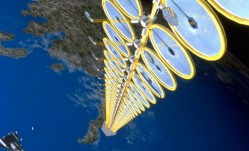In a new report, the viability of sending solar panels into space to collect a vast quantity of uninterrupted energy has been re-investigated. Although the idea has been around since the 1970's, space solar power has always been viewed as prohibitively expensive. In the current energy climate down here on Earth with spiralling oil prices and a massive push toward green energy sources, sending massive solar arrays into geosynchronous orbit doesn't seem like such a strange (or expensive) idea. There are many obstacles in the way of this plan, but the international community is becoming more interested, and whoever is first to set up an orbital array will have a flexible and unlimited energy resource…
It sounds like the perfect plan: build a vast array of solar panels in space. This avoids many of the practical problems we have when building them on Earth such as land availability, poor light conditions and night time, but sending a sunlight farm into space will be expensive to set up. In the 1970's a plan was drawn up by NASA for the possibility of orbital sunlight "harvesting", but it was deemed too expensive with a hefty price tag of at least $1 trillion. There was no country in the world that could commit to such a plan. But as we slowly approach an era of cheaper space travel, this cost has been slashed, and the orbital solar energy case file has been re-opened. Surprisingly, it isn't the most developed nations in the world that are pushing for this ultimate renewable energy source. India and China, with their ballooning populations are reaching a critical point for energy consumption and they are beginning to realise their energy crisis may be answered by pushing into space.
"A single kilometer-wide band of geosynchronous Earth orbit experiences enough solar flux in one year to nearly equal the amount of energy contained within all known recoverable conventional oil reserves on Earth today." - Pentagon's National Security Space Office 2007 report.
So how could this plan work? Construction will clearly be the biggest expense, but the nation who leads the way in solar power satellites will bolster their economy for decades through energy trading. The energy collected by highly efficient solar panels could be beamed down to Earth (although it is not clear from the source what technology will go into "beaming" energy to Earth) where it is fed into the national grid of the country maintaining the system. Ground based receivers would distribute gigawatts of energy from the uninterrupted orbital supply. This will have obvious implications for the future high demand for electricity in the huge nations in Asia and will wean the international community off carbon-rich non-renewable resources such as oil and coal. There is also the benefit of the flexible nature of this system being able to supply emergency energy to disaster (and war-) zones.
"It will take a great deal of effort, a great deal of thought and unfortunately a great deal of money, but it is certainly possible." - Jeff Keuter, president of the George C. Marshall Institute, a Washington-based research organization.
The most optimistic time frame for a fully operational space-based sunlight collection satellite would be 2020, but that is if we started work now. Indeed some research is being done (Japan is investing millions of dollars into a potential prototype to be put into space in the near future), but this is a far cry from planning to get full-scale operations underway in a little over a decade…
Source: CNN International





 RSS Feed (xml)
RSS Feed (xml)
